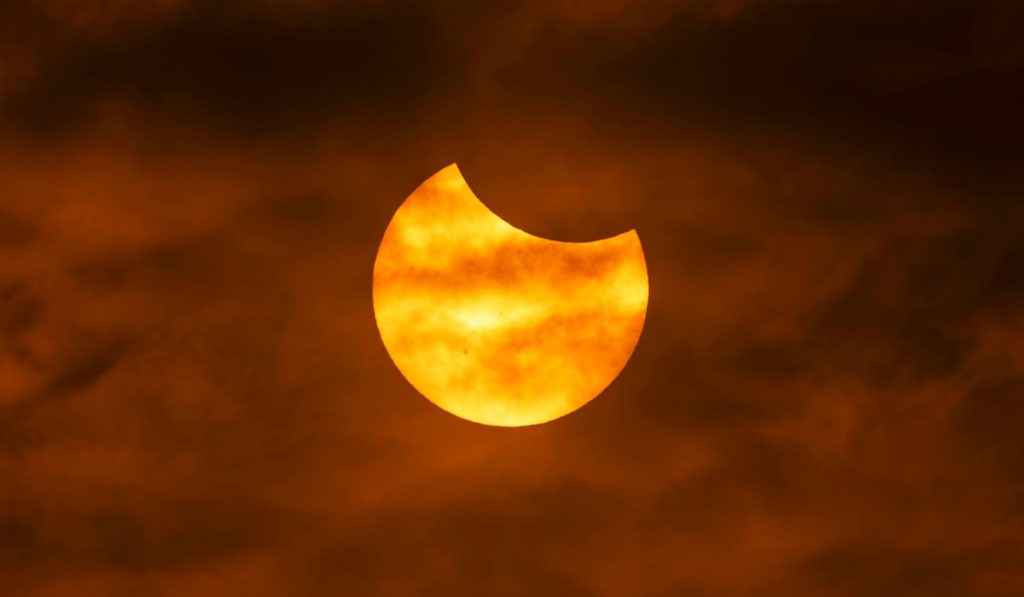 NASA 2024 Solar Eclipse Live: Path, times, how and where to see it. The total eclipse will first appear along Mexico’s Pacific coast at 11:07 a.m. PDT, then travel across parts of the United States from Texas to Maine and Canada.
NASA 2024 Solar Eclipse Live: Path, times, how and where to see it. The total eclipse will first appear along Mexico’s Pacific coast at 11:07 a.m. PDT, then travel across parts of the United States from Texas to Maine and Canada.
NASA said about 31.6 million people live in the path of totality, where the Moon will completely block the Sun. The route will be 108 to 122 miles wide, where an additional 150 million people live within 200 miles of the path of totality.
What is a Solar Eclipse?
A solar eclipse is an astronomical event in which the Moon passes between the Earth and the Sun. Due to this, the sunlight is completely or partially blocked in any part of the world.
What Happens in a Solar Eclipse?
When the Moon completely covers the Sun, it casts a shadow on Earth, called the “path of totality”. This path is a relatively narrow band that runs across the surface. People standing inside this band can witness a total solar eclipse if the weather and clouds cooperate during the path of totality, where the Moon completely covers the Sun, and the sky will be dark, looking like dawn or dusk.
If people are on that line—the path of totality—they will see only a partial eclipse. For them, the sky will appear slightly darker than before the eclipse, depending on how much the Moon blocks the Sun at their location.
When will the Solar Eclipse 2024?
The eclipse will begin in Mexico at approximately 11:07 p.m. PDT, Monday, April 8, before crossing to Texas at 1:27 p.m. CDT. It will end in Maine at 3:35 p.m. EDT. Even if you’re not in the path of totality and can’t see the total eclipse, you can still see a percentage.
Here are the major cities in each state where you can experience totality in the United States (note that the included times do not account for when the partial eclipse begins and ends):
- Dallas, Texas: 1:40-1:44 p.m. CDT
- Idabel, Oklahoma: 1:45-1:49 p.m. CDT
- Little Rock, Arkansas: 1:51-1:54 p.m. CDT
- Poplar Bluff, Missouri: 1:56-2:00 p.m. CDT
- Paducah, Kentucky: 2-2:02 p.m. CDT
- Carbondale, Illinois: 1:59-2:03 p.m. CDT
- Evansville, Indiana: 2:02-2:05 p.m. CDT
- Cleveland, Ohio: 3:13-3:17 p.m. EDT
- Erie, Pennsylvania: 3:16-3:20 p.m. EDT
- Buffalo, New York: 3:18-3:22 p.m. EDT
- Burlington, Vermont: 3:26-3:29 p.m. EDT
- Lancaster, New Hampshire: 3:27-3:30 p.m. EDT
- Caribou, Maine: 3:32-3:34 p.m. EDT
Eclipse 2024 Live Path and Time on April 8
The event may take around two and a half hours but will likely last only four minutes. According to NASA, the summit view is expected to last 4 minutes and 27 seconds while on a path of total darkness.
According to The Great American Eclipse, “totality will last 4 minutes and 27 seconds, nearly twice as long as the Great American Eclipse on August 21, 2017.” Most locations along the centerline (path of totality) will see the duration of totality between 3.5 and 4 minutes.
Where can you see the Eclipse 2024 Live Path and Time Today?
The eclipse begins in Mexico and then enters the United States through Texas. From there, the path of totality, which is about 115 miles wide, stretches northeast, crossing 13 states. In the United States, totality will end in Maine, but the eclipse will eventually enter Canada’s maritime provinces.
Other major cities along the eclipse path include San Antonio and Austin, Texas; Indianapolis; and Rochester and Syracuse, New York.
How to Watch the Eclipse Safely?
We all know that the surface of the Sun is so bright that any part of it can be felt. This creates enough light to damage individual retinal cells. Skygazers worldwide are advised to wear protective glasses such as licensed eclipse glasses during partial phases. If you fail to do this, the retina of your eye may burn and cause permanent damage or even blindness.
So solar eclipse glasses are AAS-approved 2024 – Made in USA CE and can be used as ISO-certified safe shades for viewing the Sun directly. According to the American Optometric Association, only glasses that meet the international standard ISO 12312-2 should be used to look at a partially eclipsed sun.
Eclipse 2024 Live Path and Time
| Place | Partial Starts | Partial Ends | Totality Starts | Totality Ends | Maximum | Time Zone |
| New York, Buffalo | 2:04 p.m. | 4:32 p.m. | 3:18 p.m. | 3:20 p.m. | 3:22 p.m. | EDT |
| Texas, Dallas | 12:23 p.m. | 3:02 p.m. | 1:40 p.m. | 1:42 p.m. | 1:44 p.m. | CDT |
| Ohio, Cleveland | 1:59 p.m. | 4:29 p.m. | 3:13 p.m. | 3:15 p.m. | 3:17 p.m. | EDT |
| New Hampshire, Lancaster | 2:16 p.m. | 4:38 p.m. | 3:27 p.m. | 3:29 p.m. | 3:30 p.m. | EDT |
| Pennsylvania, Erie | 2:02 p.m. | 4:30 p.m. | 3:16 p.m. | 3:18 p.m. | 3:20 p.m. | EDT |
| Missouri, Poplar Bluff | 12:39 p.m. | 3:15 p.m. | 1:56 p.m. | 1:56 p.m. | 2:00 p.m. | CDT |
| Arkansas, Little Rock | 12:33 p.m. | 3:11 p.m. | 1:51 p.m. | 1:52 p.m. | 1:54 p.m. | CDT |
| Illinois, Carbondale | 12:42 p.m. | 3:18 p.m. | 1:59 p.m. | 2:01 p.m. | 2:03 p.m. | CDT |
| Vermont, Burlington | 2:14 p.m. | 4:37 p.m. | 3:26 p.m. | 3:27 p.m. | 3:29 p.m. | EDT |
| Oklahoma, Idabel | 12:28 p.m. | 3:06 p.m. | 1:45 p.m. | 1:47 p.m. | 1:49 p.m. | CDT |
| Indiana, Evansville | 12:45 p.m. | 3:20 p.m. | 2:02 p.m. | 2:04 p.m. | 2:05 p.m. | CDT |
| Kentucky, Paducah | 12:42 p.m. | 3:18 p.m. | 2:00 p.m. | 2:01 p.m. | 2:02 p.m. | CDT |
| Maine, Caribou | 2:22 p.m. | 4:40 p.m. | 3:32 p.m. | 3:33 p.m. | 3:34 p.m. | EDT |


